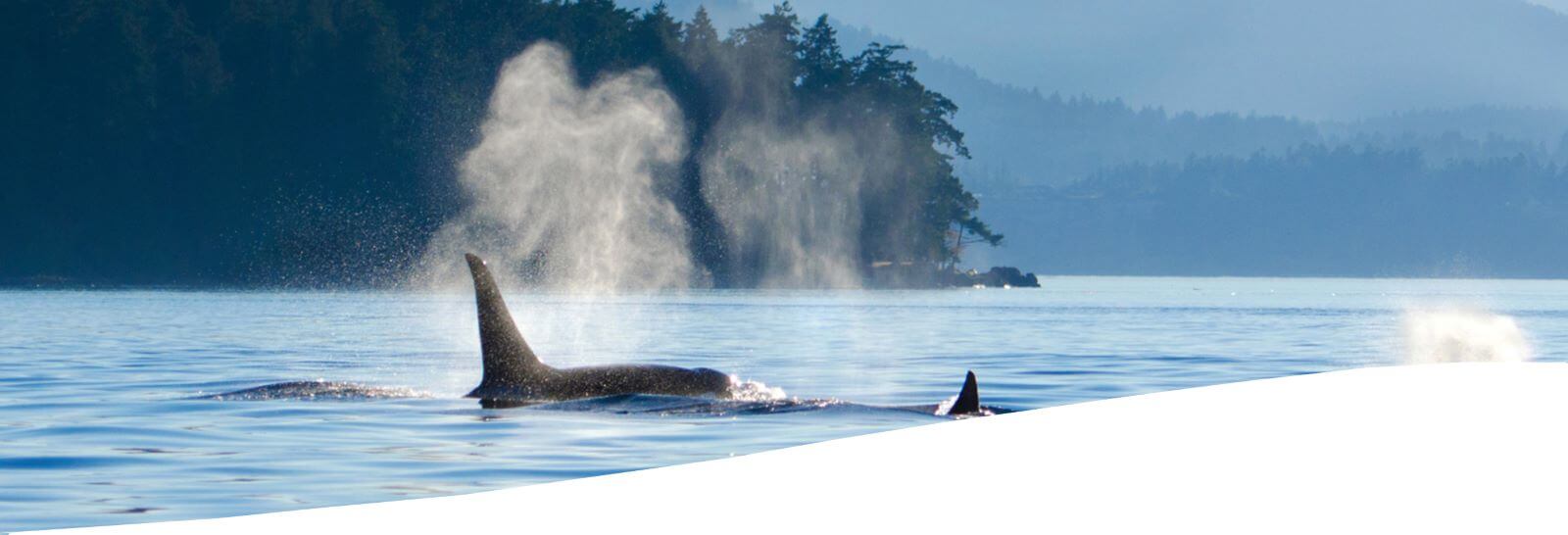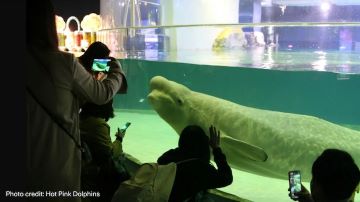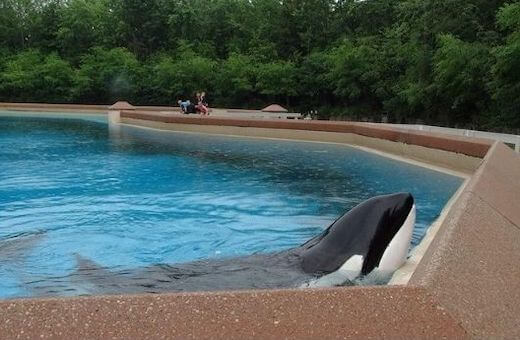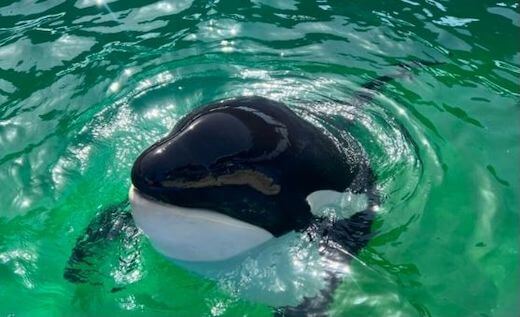
Timeline: 2015 to Present
The Whale Sanctuary Timeline
Our latest updates, along with a history of work at the sanctuary site, major Whale Aid programs, and key developments around the world in bringing an end to whale and dolphin captivity.
To stay informed about the progress of the mission please subscribe to our news updates. And your donation will hasten the time when all captive whales are retired to sanctuaries.
Sanctuary status update
November 2024

Latest update – November 2024:
November 2024: Whale Sanctuary Project and LotteWorld Aquarium sign a joint Letter of Intent “to enter a dialogue concerning the relocation of the beluga whale known as Bella from LotteWorld Aquarium in Seoul, South Korea to the sanctuary that the Whale Sanctuary Project is creating in Port Hilford Bay (Indian Harbour), Nova Scotia, Canada.”
(For other 2024 updates, scroll to bottom of page.)
Sanctuaries represent the next evolution in how we relate to cetaceans.
Creating this first of its kind whale sanctuary is a long and complex process for which the government agencies have no existing precedents. There are no shortcuts in ensuring a safe, lifelong haven for whales in captivity.
Timeline of Events: 2015 to Present
2015-2016
VISION & INCEPTION;
INCOPORATION & 501c3 TAX STATUS;
$1 MILLION PLEDGE FROM MUNCHKIN, Inc.
August 2015: At the University of British Columbia in Vancouver, neuroscientist Dr. Lori Marino convenes a group of experts and leaders in marine mammal science and behavior, veterinary medicine, husbandry, engineering, law and policy, and animal advocacy to discuss the possibility of creating a sanctuary for whales and dolphins.
December 2015: Dr. Marino and Dr. Naomi Rose of the Animal Welfare Institute mount a public workshop on what it will take to establish an authentic whale sanctuary. The following day, David Phillips, director of the International Marine Mammal Project, hosts a meeting at the offices of Earth Island Institute, where experts from around the world discuss the formation of an organization and agree on its mission and goals.
April 2016: The Whale Sanctuary Project is incorporated in Washington DC as a 501c3 tax-exempt nonprofit with founding board members Dr. Lori Marino, David Phillips, Dr. Naomi Rose and future Executive Director Charles Vinick. Don Baur, former General Counsel of the U.S. Marine Mammal Commission, serves as legal counsel. Steven Dunn, CEO of Munchkin Inc., pledges $1 million to the search for a suitable sanctuary site.
In December 2015 Senator Wilfred Moore introduces the Ending the Captivity of Dolphins & Whales Act, into the Canadian Parliament
Bill S-203 would phase out the captivity of cetaceans except for rescue, rehabilitation, licensed scientific research, or what is in the best interests of the animals.
The Bill will be debated for nearly four years before being passed overwhelmingly.
In August 2016, California Passes the Orca Protection Act, which bans captivity and breeding of orcas and their use in entertainment. (The act grandfathers in the 11 orcas at SeaWorld San Diego.)
SeaWorld announces that it is ending its orca breeding program and states that the orcas currently at its facilities will be the last.
2017
STRATEGIC PLAN CREATED;
DESKTOP SEARCH FOR CANDIDATE SANCTUARY SITES.

May 2017: The Vancouver Park Board votes in favor of no new whales, dolphins and porpoises being kept on display at the Vancouver Aquarium.
Preliminary work: The Whale Sanctuary team formulates a strategic plan for the creation and operation of the sanctuary, including:
- Financial projections for each element of the sanctuary, including animal care and veterinary facilities; staff and administrative quarters including housing; and plans for a public education and outreach center;
- Desktop and satellite imagery search of over 120 potential sites in Washington State, British Columbia, Maine and Nova Scotia, ultimately narrowing the list down to 30 potential sites.
In March 2017, Dr. Lori Marino and other members of the Whale Sanctuary team testify at Senate hearings re. The Ending the Captivity of Whales and Dolphins Act.
In her testimony, Dr. Marino explains that research using captive dolphins and whales has made little-to-no impact on conservation efforts in Canada and that there is no convincing evidence for the claim that seeing dolphins and whales on display in concrete tanks has any educational value.
2018
SITE FIELD RESEARCH & ANALYSIS;
VISITS TO CANDIDATE SITE LOCATIONS;
FIRST WHALE AID PROJECT.

Our team conducts visits to the top 30 candidate sites and prepares a Site Search Report that further narrows the list of sites in the three main regions:
- British Columbia: Beautiful bays and coves that are suited to whales but remoteness from schools and other institutions make these regions ill-suited for the long-term staffing that the sanctuary requires;
- San Juan Islands, Washington State: Again, some excellent locations for whales. But, in what is essentially the opposite situation to that of British Columbia, density of population would make it difficult to keep the needs of the whales and those of the human population from intruding upon each other;
- Nova Scotia: Several local communities step forward to offer help in determining suitable sites. We learn that there was historical gold mining in several regions of the province from the 1880s to the 1930s and that there may be remnants of gold mine tailings on any site we select. Environmental site assessments will be required to determine any necessary mitigation measures.
August 2018: The Whale Sanctuary Project joins an emergency effort by the National Oceanic & Atmospheric Administration in the Pacific Northwest to try to save the life of the four-year-old orca J-50, known as Scarlett. Two of our expert team members, Jeff Foster and Katy Laveck Foster, coordinate much of the fieldwork. Although J-50 does not survive, the effort underscores the need for advance planning for future rescue and rehab efforts for the Southern Resident orcas.
As part of our due diligence in Nova Scotia, we learned that there was historical gold mining in several regions of the province from the 1880s to the 1930s and that there may be remnants of gold mine tailings on any site we select.
Environmental site assessments (the ESA process) will be required to determine any necessary mitigation measures.
2019
NOVA SCOTIA SITES FIELD RESEARCH & ANALYSIS;
WHALE AID RUSSIA;
CANADA PASSES BILL S-203.

April 2019: The Russian government invites a Whale Sanctuary Project team to Moscow to help create a Whale Aid plan to return 97 recently captured orcas and beluga whales to the ocean. On our return from Russia, we report to the Russian government that “the team has not identified any scientific reasons why any individual animals cannot be rehabilitated and released.”
June 2019: Canada passes legislation, Bill S-203, that bans keeping whales, dolphins and porpoises in captivity for entertainment. Whales and dolphins in captivity at the time of passage into law are grandfathered in – meaning that whales at Marineland Canada may remain there.
June 2019: In Russia, the first group of captive whales begins their journey to the Shantar Islands in the Sea of Okhotsk, where they are released into the ocean in the area from which they were caught the previous year.
October 2019: One site in Port Hilford Bay, Nova Scotia, stands out as meeting all the requirements for a sanctuary. Due diligence and site analysis proceed.
Whale Aid Russia was – and remains – the largest rescue effort in the history of captive whales.
In Canada, Bill S-203 took nearly four years to be passed into law in the face of obstruction by special interests. Forty witnesses, including six experts from the Whale Sanctuary Project, testified at 17 committee hearings.
2020
SITE SELECTION;
SITE DEVELOPMENT;
ENVIRONMENTAL STUDIES.

January 2020: Meeting with Regional Chief Paul Prosper to seek the input of the Mi’kmaq people regarding establishing a sanctuary in Port Hilford Bay, Nova Scotia. The site we are considering is located on the ancestral lands of the Mi’kmaq, the First Nations people who have lived in the region for thousands of years and who have a deep cultural and spiritual connection to the ocean. We include in our sanctuary planning having a strong collaboration with the Mi’kmaq people as an essential element of the success of the project and are gratified to learn from Chief Prosper that it has his support.
MILESTONE – February 2020: The Whale Sanctuary Project announces choice of Port Hilford, Nova Scotia, for the creation of a sanctuary to which whales can be retired from entertainment parks and aquariums.
March 2020: In response to the COVID-19 pandemic, the U.S./Canada border is closed, as are most Canadian government offices. Businesses and other organizations have reduced operations. Many of our plans for site development are hampered through the rest of the year. Work can proceed, however, with some of the environmental data collection.
MILESTONE March 2020: Environmental studies begin, including:
- First freshwater survey (to be conducted annually). We learn that streams are clean and calculate how much freshwater is entering the bay;
- Regular site visits to measure water levels in the bay;
- Algae samples;
- Seasonal marine and freshwater samples;
- Water temperature and level analyses (conducted through 2021);
- Collection of water samples;
- Identification of invertebrate samples and their sensitivity to any water pollution.
June 2020: Deployment of hydrophones and microphones to record noise and measure the volume at each frequency to learn how quiet or loud it is underwater. We want to know whether the sounds of boats or any other noise will have an impact on their hearing frequencies.
July 2020: First hydrodynamic modeling work begins.
July-September 2020: Next set of studies includes:
- Acoustic doppler current profilers to learn how fast the water moves and in what direction at different depths;
- Multibeam sonar to map a detailed picture of the seafloor and learn with precision areas that are shallow and deep;
- Benthic survey using a GoPro camera mounted to a photo drop frame on the seafloor to identify the substrate type along with flora and fauna. Benthic animals are those who live in or on the seafloor, and benthic surveys help scientists assess the health of estuaries and coastal waters.
- Land use survey;
- Flushing rate survey in sanctuary waters to help determine how many whales we can bring into the bay while preserving the marine environment.
- See also here for more about these studies.
August 2020: Merlin Entertainments, a U.K. company with a “no captive whales or dolphins” policy, moves two belugas from a facility it has purchased in China to an indoor area adjacent to the coastal sanctuary environment their non-profit company, Sea Life Trust, is establishing in Iceland.
Storm tracking: Hurricane Teddy provides an opportunity for precise storm tracking at the sanctuary site to learn whether debris comes ashore during significant weather events and whether there are locations where more or less debris accumulates. This helps us plan our operations for all types of weather events.
In February 2020, the Canadian Senate pays tribute to work of Whale Sanctuary Project and congratulates the community of Port Hilford Bay and Nova Scotia for being selected for this sanctuary.
In August, the government of Brussels, Belgium, announces plan to ban keeping of marine mammals at entertainment facilities.
In September, France’s Minister of Ecological Transition, Barbara Pompili, announces plan to bring an end to keeping cetaceans in captivity, immediately banning their import and breeding.
And in November, Canadian Senator Murray Sinclair partners with Dr. Jane Goodall to introduce the Jane Goodall Act. This bill has the potential to establish the strongest legal protections for captive wild animals anywhere in the world. It also increases protections for captive whales and dolphins.
2021
SITE DEVELOPMENT;
ENVIRONMENTAL STUDIES;
LOCATION OF NET PLACEMENT DETERMINED;
WHALE AID WORK FOR ORCA TOKITAE;
PRELIMINARY DISCUSSIONS WITH MARINELAND CANADA;
VISITOR & OPERATIONS CENTRE OPENS.

By now, we are deeply involved in work with stakeholders in the project at all levels, from community officials and committees to tribal authorities of the Mi’kmaq Nation to provincial and federal authorities that are charged with issuing the necessary permits.
January – April: Overwintering and migratory bird survey.
WHALE AID February 2021: At the request of the Sacred Lands Conservancy, an indigenous-led non-profit on the West Coast, expert members of the Whale Sanctuary Project team draft and submit a comprehensive operational plan to safely bring the orca Tokitae (also known by her display name “Lolita”) from the Miami Seaquarium back to her home in the Salish Sea. This Whale Aid project is grounded in and guided by Lummi ancestral wisdom as well as science and is subject to all regulatory approvals and receipt of government permits. Many of the components of this plan also have direct application to what will be involved in evaluating, preparing and transferring any whale from a marine entertainment park or aquarium to a sanctuary.
MILESTONE March 2021: After the first year of site development work, we are in a position to decide specific placement of the sanctuary enclosure.
July 2021: Lidar study initiated. The Lidar survey provides a digital 3-D representation of the sea floor of the sanctuary.
Acoustic doppler current profiler is deployed to learn speed and direction of water at different depths.
Multibeam sonar is deployed to make a detailed picture of the seafloor, to make a detailed picture of the seafloor, showing areas that are shallow and deep. The survey will also identify any anomalies in the sea floor and tell us whether there could be a sunken boat (or even an old car that may have been dumped into the bay!).
Hydrophones and microphones are deployed to record noise in order to measure the volume at each frequency and tell us how quiet or loud it is underwater. Hydrophone spectrograms help us learn how sounds of boats and other noises may affect the whales.
August 2021: Water and sediment sampling at a variety of locations in the bay leading to lab analyses for metals and to measure nutrient levels to test for any contaminants in the water.
MILESTONE October 2021: Operations & Visitors Center opens. In a formal ceremony, Kerry Prosper, the Knowledge Keeper of the Mi’kmaq people, opens the proceedings, the ribbon is cut by the Lt. Governor of Nova Scotia, and additional remarks are offered by Hon. Wilfred Moore, who introduced Senate Bill S-203, The Ending of Captivity for Whales & Dolphins Act, into Parliament, and other local, provincial, federal and indigenous leaders. Renowned artist Alan Syliboy donates two paintings to the center.
Since its opening, the Operations & Visitors Center has seen consistent growth in the number of yearly visitors eager to learn about the project.
December 2021: We hold preliminary discussions with Marineland Canada about the possibility of transferring whales from their facility to the sanctuary at the appropriate time. The meeting is cordial and positive, and we even set some dates for further meetings. Three days later, however, the Niagara police charge Marineland with using whales and dolphins for entertainment purposes, which is prohibited under the 2019 Ending the Captivity of Whales and Dolphins Act. At that point, Marineland breaks off further discussion with the Whale Sanctuary Project.
In October 2021, new and deeply disturbing facts are revealed in a report by the U.S. Department of Agriculture about life for marine mammals, including its lone orca Lolita, at the Miami Seaquarium. The report notes that management has repeatedly ignored the urgent recommendations of its attending veterinarian.
2022
SITE DEVELOPMENT;
ENVIRONMENTAL STUDIES;
OFFER OF LEASE FOR SANCTUARY WATERS;
FIRST NATIONS ARCHEOLOGIAL RESOURCE IMPACT ASSESSMENT (ARIA) REPORT;
WENDY P. MCCAW FOUNDATION PLEDGE OF SUPPORT;
WHALE AID TOKITAE;
PRELIMINARY DISCUSSIONS WITH MARINELAND CANADA.

WHALE AID March 2022: A new organization, Friends of Toki, has been working with the new owners of the Miami Seaquarium with the goal of returning Tokitae, the orca also known as Lolita, to an ocean habitat in her home waters in the Pacific Northwest. On March 30th Friends of Toki holds a press conference at which Miami-Dade County Mayor Danielle Levine Cava announces an agreement with the Miami Seaquarium, by which the company will provide access to the Tokitae for a team of independent veterinarians and other experts to conduct a comprehensive evaluation of her physical and mental health.
As part of our Whale Aid program, WSP is providing advice and expertise for the purpose of addressing Tokitae’s health and welfare needs. Our Executive Director, Charles Vinick, is serving as a volunteer board member of Friends of Toki. Jim Irsay, principal owner of the Indianapolis Colts, offers to provide funding for all the work that will be involved.
In May, veterinarians Dr. Stephanie Norman and Dr. Jim McBain initiate the first independent assessment of physical and mental health of Tokitae.
SANCTUARY MILESTONE March 2022: WSP receives the Offer of Lease from the Canadian government’s Department of Natural Resources & Renewables. The Offer of Lease makes available to the sanctuary a total water space of 205 acres. This includes 100-plus acres for the whales, Barachois Island, a security zone around the sanctuary, and the space needed for the anchoring system. The lease will take effect after all permits have been issued.
March 2022: Completion of full hydrodynamic modeling, including lidar.
April 2022: Civil, structural, electrical, mechanical and geotechnical engineering studies are conducted at the Nova Scotia site. These will be used to determine and design placement of all infrastructure, including power, water and septic systems.
June 2022: the Whale Sanctuary Project executes the Department of Natural Resources & Renewables’ Offer of Lease.
June 2022: Nova Scotia Community College researcher completes 3D hydrodynamic model of the sanctuary site. The model is based on data gathered from the seafloor, tidal current velocities and flushing rates.
August 2022: Completion of our two-year study of tidal flows, water pressure and other conditions opens the way toward positioning the anchoring structure and the perimeter net.
August 2022: A new work boat, funded in large part by donations from members of the Animal Welfare Institute takes to the water at the sanctuary site for the first time.
September 2022: Prior to being able to conduct a formal Environmental Site Assessment III, we initiate an Archeological Resource Impact Assessment (ARIA) as part of our First Nation consultation. The purpose of an ARIA is to highlight areas of potential archeological sensitivity associated with our proposed project. This ARIA is conducted in accordance with the terms of Heritage Research Permit A2022NS177, issued by the Nova Scotia Department of Communities, Culture, Tourism and Heritage (CCTH) – Special Places Program.
September 2022: Hurricane Fiona comes ashore in Nova Scotia as the most powerful and destructive tropical storm to hit Canada on record, causing considerable damage to communities near the sanctuary site. It also provides an opportunity to check how similar weather events could impact the sanctuary perimeter net and other facilities. We observe, once again, that the sanctuary site is located in a sheltered area of Port Hilford Bay.
MILESTONE November 2022: The Wendy P. McCaw Foundation pledges $5 million toward the Building Fund for construction of the sanctuary buildings, the state-of-the-art perimeter net that will surround the sanctuary waters, and the sanctuary infrastructure, including power, water and internet.
November 2022: Completion of the Archeologic Resource Impact Assessment.
In March 2022, Senator Marty Klyne reintroduces the Jane Goodall Act to the Canadian Senate as Bill S-241 with new and stronger provisions. He notes that the Ontario Government has jurisdiction to grant civil standing to Kiska, the lone orca at Marineland Canada.
In July, The Strengthening Welfare in Marine Settings (SWIMS) Act is introduced into the United States Congress to prevent the future capture and breeding of whales for public display and thus, over time, to end the exploitation of whales in entertainment parks and aquariums.
2023
SITE DEVELOPMENT;
ENVIRONMENTAL STUDIES;
TOPOGRAPHIC STUDY, IN-WATER FIELD SURVEY;
MI’KMAQ ECOLOGICAL KNOWLEDGE STUDY;
ENVIRONMENTAL SITE ANALYSIS PROCESS COMPLETED.

February 2023: Topographic study provides the shape and features of the 30 acres of sanctuary land to determine the optimal locations for veterinary/medical suite, animal care facilities, marine operations workshop, net loft, observation tower, boat ramp, security, and maintenance facilities.
March 2023: Death of Kiska, the lone orca at Marineland. The news is devastating to all of us who have been working toward the time when she could be retired to sanctuary. Captured in 1979 at around age three from the North Atlantic Ocean, Kiska gave birth, as a young adult, to five calves, all of whom died young. Kiska spent more than 40 years at Marineland and had been alone in her tank since 2011.
April 2023: The Whale Sanctuary Project notifies the Kwilmu’kw Maw-klusuaqn Negotiations Office that it has completed environmental analyses to determine recent and current use by the Mi’kmaq people.
June 2023: Preliminary in-water field survey to advance our understanding of key areas in sanctuary waters and to identify species of marine vegetation. This survey helps establish parameters for the upcoming final study of the ESA process.
The ESA is a key requirement in understanding the health and suitability of the ecosystem for whales who are being retired from marine entertainment parks.
July 2023: A team of divers assembles at the sanctuary site to collect 27 sediment samples collected from several locations across the site for the ESA.
August 2023: Tokitae dies at Miami Seaquarium after a months-long effort to rehabilitate and return her to her home waters off the coast of Washington State, USA. While Toki was not a candidate for the sanctuary in Nova Scotia, and while the Whale Sanctuary Project was not directly involved in the recent efforts to free her, several of our team members had participated in Toki’s care, offering their unique expertise to the work.
October 2023: We are awaiting results from the laboratory on the final stages of the Environmental Site Assessment. Meanwhile, we continue to press ahead on plans for our net structures and are actively engaging with aquariums and marine parks around the world to identify the whales who will eventually become sanctuary residents.
December 2023: We have received the results of some recent environmental studies we’ve been conducting at the sanctuary site in Nova Scotia. The last of these studies, an Environmental Site Assessment III (ESA III), was completed in July, when a team of divers took samples of soil from the seabed so that we could send them for laboratory analysis.
The results are posted on the blog.
In January 2023, whale and dolphin lovers celebrate the tenth anniversary of the release of the documentary Blackfish, which rocked SeaWorld and the entire marine park entertainment industry with its revelations about the extreme stress that captive cetaceans experience living in concrete tanks.
In July 2023, the Global Federation of Animal Sanctuaries publishes the first ever set of best practices for whale and dolphin sanctuaries. The guidelines are the product of collaboration among the Whale Sanctuary Project, the National Aquarium, Sea Life Trust, and Merlin Entertainments.

The death of Kiska (photo above) in March was a devastating blow, felt around the world. Our hope was that she could be one of the first whales to be retired to the sanctuary.
In the case of Toki (photo below), who died in August, the plan had been for her to be retired to a sea pen in the Salish Sea, from where she had been captured.

The passing of Kiska and Toki only highlights the urgency of creating sanctuaries for the many whales and dolphins still living at entertainment parks.
2024
WORK ON BEHALF OF THE ORCAS AT MARINELAND ANTIBES;
SITE WORK ACCELERATED PLANS.

February 2024: Together with One Voice, a French NGO, the Whale Sanctuary Project issues a press statement proposing a collaboration with the theme park Marineland Antibes in the south of France to retire Wikie, Inouk and Keijo, a family of orcas to the sanctuary in Nova Scotia. This proposal comes in the wake of our learning that Marineland is planning to send the family to an aquarium in Japan.
February 2024: The Strengthening Welfare in Marine Settings (SWIMS) Act is reintroduced to the U.S. Congress by four congressmen. The act would end the future capture and breeding of whales for public display.
March 2024: The Whale Sanctuary Project begins work on an accelerated plan to be able to accommodate the orcas Wikie, Inouk and Keijo before the full sanctuary is completed. The plan involves designing and fabricating a large bay pen where the whales can live comfortably and become accustomed to life in the ocean while the full sanctuary perimeter net is completed. Temporary facilities would also be made available for regular care of the whales and veterinary and operational requirements.
March 2024: At the end of the month, we learn that Inouk has died, leaving his sister, Wikie, and his nephew, Keijo, in ever-deeper distress and in greater need of transfer to sanctuary. Dr. Jane Goodall sends a letter to the French government endorsing the sanctuary in Nova Scotia as the best option for Wikie and Keijo.
April 2024: In response to the French government’s call for “Expressions of Interest” in offering options for a new home for the orcas Wikie and Keijo, we submit an extensive document including a complete operational plan for every stage of transferring the whales to the sanctuary in Nova Scotia.
June 2024: Work is now proceeding on the design of the bay pen, a central feature of the sanctuary, where every whale who comes to the sanctuary will live for a period of acclimatization to their new, natural environment. The bay pen is considerably larger than any concrete tank at any entertainment park in the world. It will also be engineered and fully equipped to handle all aspects of veterinary and routine care for the whales.
September 2024: The French government’s General Inspectorate of the Environment & Sustainable Development releases its formal recommendations regarding whales and dolphins who are in captivity at theme parks and aquariums in France. They recommend Whale Sanctuary Project as the best sanctuary solution for the mother-and-son orcas Wikie and Keijo at Marineland Antibes.
November 2024: The Whale Sanctuary Project and LotteWorld Aquarium sign a joint Letter of Intent “to enter a dialogue concerning the relocation of the beluga whale known as Bella from LotteWorld Aquarium in Seoul, South Korea to the sanctuary that the Whale Sanctuary Project is creating in Port Hilford Bay (Indian Harbour), Nova Scotia, Canada.”
November 2024: French Minister of Ecological Transition announces her opposition to orcas Wikie & Keijo being transferred to Kobe Suma aquarium in Japan. “I have heard the warnings from NGOs about the future of the two orcas at Marineland … So, I have decided to oppose the transfer of Wikie and Keijo to Japan.” She also posts one of the letters she has received from schoolchildren in Texas.
In early February, we learned of the death of Steven M. Wise, founder and president of the Nonhuman Rights Project. Steve’s work gained worldwide attention in 2013 when he filed a series of first-ever lawsuits on behalf of captive chimpanzees, arguing that as cognitively complex, autonomous beings, they should be recognized as having the fundamental right to bodily liberty.
On September 2nd, beluga whale Hvaldimir is found dead in Risavika Bay, Norway, near the town of Stavanger. An autopsy will find a stick lodged in his throat and an ensuing bacterial infection. Hvaldimir had been living free since April 2019, to the delight of residents and tourists, after having apparently escaped from a Russian naval base.

November 24th: The Honourable Murray Sinclair, Anishinaabe former senator, judge and leader in Canada’s justice system, dies at age 73. His legacy is one of empathy, justice and compassionate action for human and non-human societies. Beyond his work leading Canada’s landmark Truth and Reconciliation Commission, he was a beacon of change for animals with his work in Parliament on Bill S-203, the Ending the Captivity of Whales and Dolphins Act.